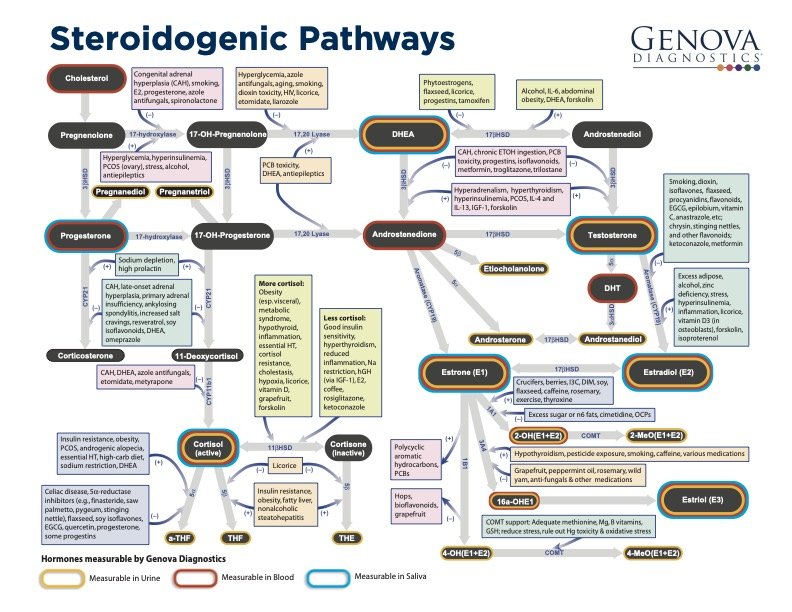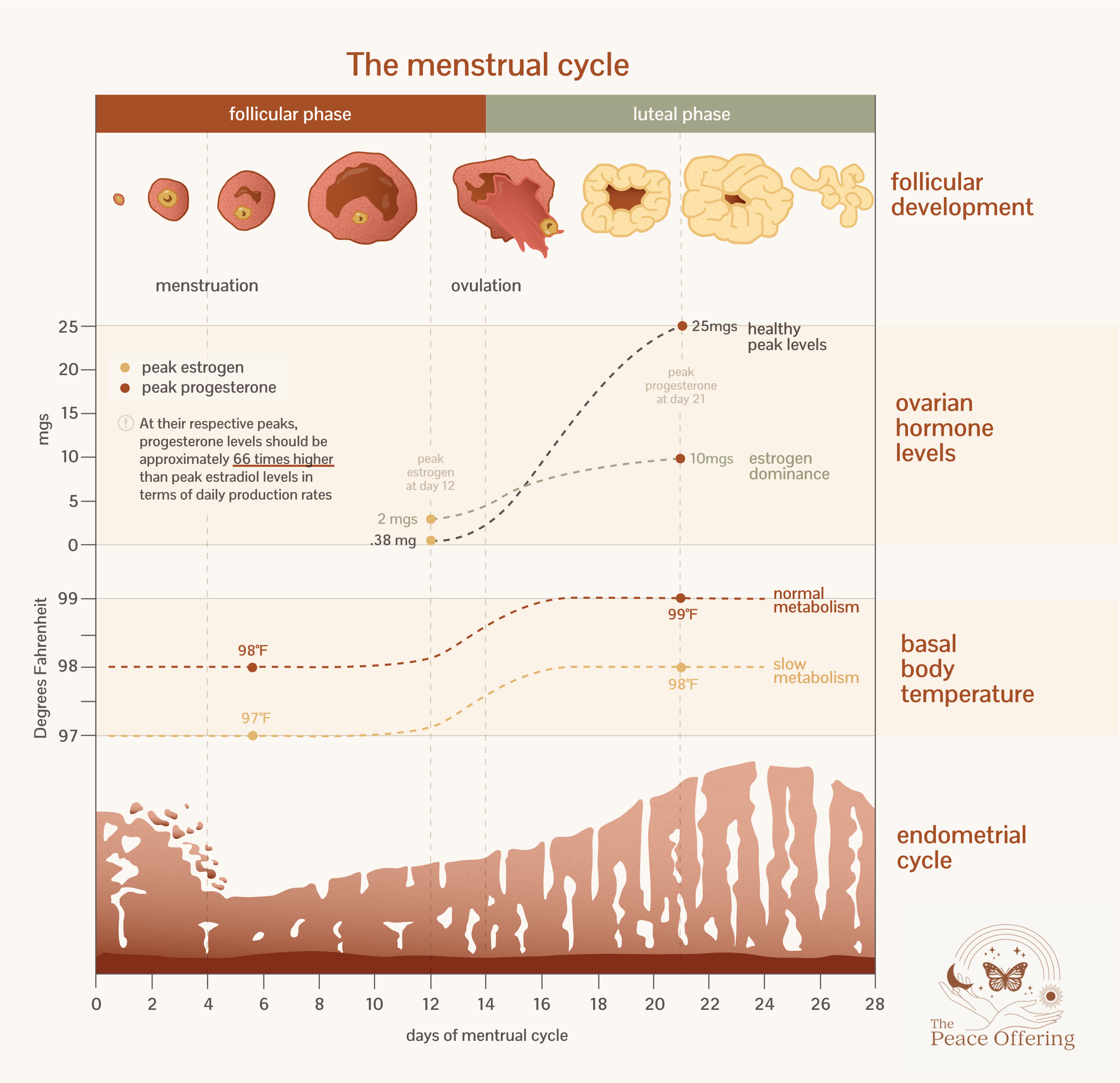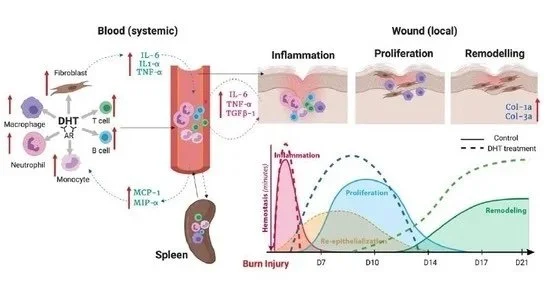Optimizing Sex Hormones
Fertility, mood, metabolic rate, regeneration, vitality, strength, and stress resilience are the main features of youth hormones. As we age, they decline naturally. However, in our current environment they’re declining much faster than they otherwise would.
Youth hormones are in the steroid family. As we’re about to learn, some of these steroid hormones are anti-metabolic. If you’re considering taking T, estrogen or birth control, you’ll definitely want to understand this. Also, if you’re feeling moody, apathetic, or generally fatigued…
TLDR:
Cholesterol is the primary substrate for making youth hormones. If its too low, it will negatively impact them.
Pregnenolone, the mother steroid, is made in the gonads, adrenals and brain. It has neuro-protective and anti-inflammatory properties.
Progesterone is the primary female youth hormone that is negatively impacted by cortisol and estrogen.
Testosterone is the primary male youth hormone that is negatively impacted by the same.
Cortisol and estrogen are considered aging hormones and are continuously made until end of life as progesterone and testosterone decline. They’re also the main drivers of hypothyroidism.
Seed oils and plastics mimic endogenous estrogen and similar effects on youth hormones.
The beginning of steroid hormone creation starts with cholesterol which is either dietarily consumed or produced by the liver. The liver packages the cholesterol into low density lipoproteins (LDL-c) to be exported into the bloodstream. One of cholesterol’s destinations are the endocrine glands responsible for generating those steroids - the adrenals, ovaries, testes and specific areas of the brain. LDL is included in a standard lipid panel with much controversy around its relationship to arteriosclerosis.
The word steroid is derived from cholesterol and refers to a class of organic compounds with a characteristic structure of four fused carbon rings. It is the primary substrate for the all five categories of steroid hormone: glucocorticoids (cortisol), mineralocorticoids (aldosterone) , androgens (testosterone, DHEA, DHT), estrogens (1,2 and 3), and progestogens (progesterone, allopregnenalone).
Having adequate cholesterol is necessary for making enough of the youth hormones. Individuals with low cholesterol, and in particular those with low LDL-c, can be found with correspondingly low sex hormones. This is why vegan diets and those taking statins typically have lower youth hormones.
It’s also important to remember pro-hormone vitamin d3 creation in the skin requires both cholesterol and UV-B. Its referred to a seco-steroid coming from the latin, to cut. The B-ring of its cholesterol-derived backbone is split open by UV-B and it then binds to vitamin d receptors (VDR) to regulate gene expression, much like cortisol or testosterone.
Once LDL-c arrives at the gonads and adrenals, it has to dock to LDL-c receptors on the cells. This allows the cholesterol to be released from the lipoprotein and enter. Once inside the cell its shuttled to the outer mitochondrial membrance and then the inner mitochondrial membrane where the conversion occurs.
T3 and vitamin A are integral to this process. T3 increases the amount of LDL receptors on the cell surface. It also upregulates the mitochondrial rate of production. As a result, if you’re hypothyroid you typically have less pro-metabolic hormones because less cholesterol is entering the cell and the tempo of production is slow. Historically, high cholesterol was a marker of hypothyroidism and T3 would be prescribed to reduce it.
Both T3 and Vitamin A, specifically its active metabolite retinoic acid, upregulate the Steroidogenic Acute Regulatory (StAR) protein that transports cholesterol inside the cell to the mitochondria for steroidogenesis. Once inside the mitochondria, cytochrome P450scc enzymes convert cholesterol into the first steroid hormone, pregnenolone.
Pregnenolone is classified as a neuro-steroid because it not only is synthesized in the gonads and adrenals, but also within the central nervous system, particularly the brain. It modulates neuronal excitability and has been implicated in various neurological functions, including memory, mood regulation, and stress responses.
Supplemental pregnenolone is considered a pro-hormone that doesn’t cause negative feedback and is useful during high stress times, therapeutically for cognitive decline, or when sex hormones are low.
All other steroid hormones are made from pregnenolone.
Once pregnenolone is synthesized from cholesterol, the type of tissue it is produced in determines the subsequent steroid hormones that will be created. If pregnenolone is made in the adrenals, its converted into the corticosteroid cortisol and the mineralocorticoid aldosterone as well as the androgen DHEA.
In the ovaries, pregnenolone is converted into progesterone and DHEA. DHEA converts to testosterone which aromatizes into estradiol.
In the testes, pregnenolone is converted into testosterone.
In the brain, pregnenolone and its metabolites, like pregnenolone sulfate and allopregnanolone, act as neurosteroids influencing neurotransmitter activity. These neuro-steroids modulate GABA (relaxation), NMDA (stimulation), and cannabinoid receptors, affecting mood, memory, and cognitive functions. It’s becoming more popular therapeutically for Alzheimer’s.
Progesterone is the quintessential female hormone. It’s the most produced ovarian hormone and it’s job is to balance estrogen production, prepare the uterus for conception and sustain the fetus until birth. Production lowers with age and is significantly decreased post-menopause while estrogen continues to be produced peripherally in tissues due in part to aromatase activity.
Progesterone serves as a precursor for the synthesis of other steroid hormones, such as cortisol, aldosterone, and testosterone.
Progesterone increases temperature and metabolic rate by supporting thyroid function. It has a calming effect on the brain and can help to reduce anxiety as well as promote a sense of well-being via its metabolite, allopregnanolone. It interacts with GABA (gamma-aminobutyric acid), which has a relaxing effect on the nervous system.
In women, peak progesterone is around day 21 (during luteal phase) ranging from 5-20 ng/mL with levels 100-500 times higher than estradiol at that time. For comparison, peak estradiol during follicular phase is 0.15-0.45 ng/mL. Progesterone’s peak is roughly 40 times higher than estradiol’s peak. Healthy cycling females average 12 ng/mL and healthy males average .6 ng/mL (~20x more in females).
Progesterone deficiency and/or estradiol excess during luteal phase causes the symptoms prior to menses (cramping, mood imbalance, etc) aka pre-menstrual syndrome.
Ovulation is required to produce progesterone however in PCOS, it doesn’t occur. Progesterone deficiency is a pre-exisiting condition for PCOS.
Bio-identical progesterone doesn’t have negative feedback so supplementation is safe. Health Natura has quality progesterone and should only be used from Day 14-28 (Luteal Phase) for cycling women. For postmenopausal women, it can be consumed almost daily.
Testosterone in men is made in the testes and generated in females by the adrenals and ovaries. Generally, healthy men are above 800 ng/dL and healthy women about 40 ng/dL total testosterone. That’s roughly a 20x difference. Testosterone can be synthesized from two different precursor molecules: progesterone and dehydroepiandrosterone (DHEA). The most potent androgen is downstream of testosterone, dihydrotestosterone (DHT).
Testosterone stimulates red blood cell production, enhances muscle strength and type I fibers, and significantly, positively affects cardiovascular function and integrity. Low T causes infertility, low libido, muscle loss, erectile dysfunction. T is decreased by elevated cortisol, estrogen, and prolactin.
Anecdotally, the most impactful feature of older men taking testosterone is the their reporting of improved mood and cognition.
The biggest sex hormone differences between females and males are between Progesterone and Testosterone, respectively. And both of these hormones directly oppose estrogen and cortisol.
Dihydrotestosterone (DHT) is 2.5 to 3x more potent than testosterone due to its higher affinity for androgen receptors. This means that DHT can exert stronger effects on tissues that express these receptors.
DHT is synthesized from testosterone by the enzyme 5α-reductase, primarily in peripheral tissues like the prostate 20%, skin & hair follicles 60%. When you think of deep voice and body hair, DHT is responsible.
More DHT is not necessarily better as 5α-reductase can be up-regulated due to elevated cortisol. The cost of this is loss of testosterone so what you really want is an optimal ratio between T and DHT.
DHT is also active in the brain and is currently used for treating dementia. It demonstrates strong neuro-protection in LPS-induced neuro-inflammation by suppressing pro-inflammatory cytokines.
E1, E2, and E3 refer to different forms of estrogen.
Estradiol (E2) is the most potent and predominant form of estrogen. It is synthesized primarily from testosterone through the action of aromatase.
The aromatase enzyme exists in the ovaries, adrenals and adipose tissue. Because of the ubiquitous nature of adipose tissue, estrogen continues to get produced in both females and males until death. Generally, the greater the fat mass, the more aromatase activity. Unfortunately this occurs at the tissue level and rarely shows up in a blood test (unlike ovarian aromatase). However, prolactin is a good proxy marker for peripheral estradiol status.
Healthy cycling females average 150 pg/ml estradiol and healthy males average about 25 pg/mL (6x more in females).
Birth control (Progestin and copper IUDs) increases estrogen, decreases progesterone and creates very similar downstream anti-metabolic, pro-cortisol and pro-inflammatory states as excessively produced endogenous estradiol. Progestin, the most common chemical birth control, is derived from testosterone and its androgenic/estrogenic cross-reactivity can disrupt estrogen-progesterone balance, leading to relative estrogen dominance. In the bioenergetic space estrogens are considered pro-aging hormones, not “female hormones”.
Vitamin E is a powerful anti-estrogen molecule with a typical dose is 400-800 IU/day taken with food.
Estrogen can increase the expression of cyclooxygenase enzymes (COX-1 and COX-2), which synthesize prostaglandins from arachidonic acid (PUFA). Prostaglandin E2 (PGE2) has been shown to stimulate the aromatase enzyme thereby increasing estrogen levels.
Similar to prostaglandins, arachidonic acid increases leukotriene synthesis. In conditions such as asthma, where leukotrienes play a significant role in inflammation and bronchoconstriction, estrogen has been implicated in exacerbating symptoms by enhancing leukotriene activity.
Because of the increase of prostaglandins and leukotrines, elevated estrogen is associated with autoimmune conditions. Blocking COX and LOX enzymes through aspirin (willow bark) and baicilin (Chinese skullcap), respectively, can lower estrogen caused by prostaglandins and leukotrienes and reduce systemic inflammation.
Omega 6 PUFA directly amplifies estrogen signaling and inhibits progesterone signaling because linoleic acid is an estrogenic compound. PUFA stimulates estrogen receptors and inhibits androgen receptors.
If stress and seed oils weren’t enough, we can thank the ubiquitous plastic in our food and environment for providing a constant drip of low-dose estrogen. BPA and Phthalates leach into products via contact with oils and alcohols in cosmetics or heat, like microwaving food in plastic.
BPA and Phthalates, found in plastic packaging and food containers, are known as xenoestrogens, mimicking estrogen in the body. They do this by binding to estrogen receptors.
This directly impacts health by pushing everyone towards and potentially into estrogen dominance and thus hypothyroidism, infertility, PCOS, and increased cancer risk (breast, prostate).
A recent study found that 100% of the 23 men’s and 47 male dog’s testes analyzed had micro plastics. The men had 3x the amount of dogs - not a good idea to wear polyester or synthetic underwear.
based on optimal values published at https://www.optimaldx.com/research-blog
What’s clear from this table is that women need to maintain optimally high levels of progesterone and keep estrogen, androgens and cortisol optimally low (relative to progesterone).
Estrogen-dominant hypothyroidism and insulin-resistant PCOS are rampant nowadays.
The Pg/E2 ratio is commonly used to determine the success of implantation during IVF and probability of miscarriage.
based on optimal values published at https://www.optimaldx.com/research-blog
What’s clear from this table is that men need to keep estrogen and cortisol optimally low to prevent the loss of testosterone.
Insulin-resistance driven belly fat causing increased estrogen along with aforementioned environmental insults is creating anhedonic males with learned helplessness.
Total Testosterone below 300 ng/dL leads to infertility.
Solutions
Eliminate seed oils and replace with coconut oil, ghee/butter and tallow
Lower stress by eating enough calories and easily digestible carbs, slowing down life and nose breathing slowly
Minimize plastic contact with your food, drink and clothing; Use glass and stainless steel; natural fibers for clothing
Sweat has been shown to detoxify BPA and Phthalates very effectively
Eat enough cholesterol and vitamin A from egg yolks, liver and butter
Optimize thyroid function via suggestions above along with potentially supplementing selenium (seafood) and NDT
Women, potentially supplementing progesterone; Men, potentially supplementing pregnenolone
Get great sleep
Walk 10k+ steps/day and strength train 2-4x week
To your health,
Jonathan
This is for informational purposes only and should not replace professional medical advice. Consult with your physician or other health care professional if you have any concerns or questions about your health.











